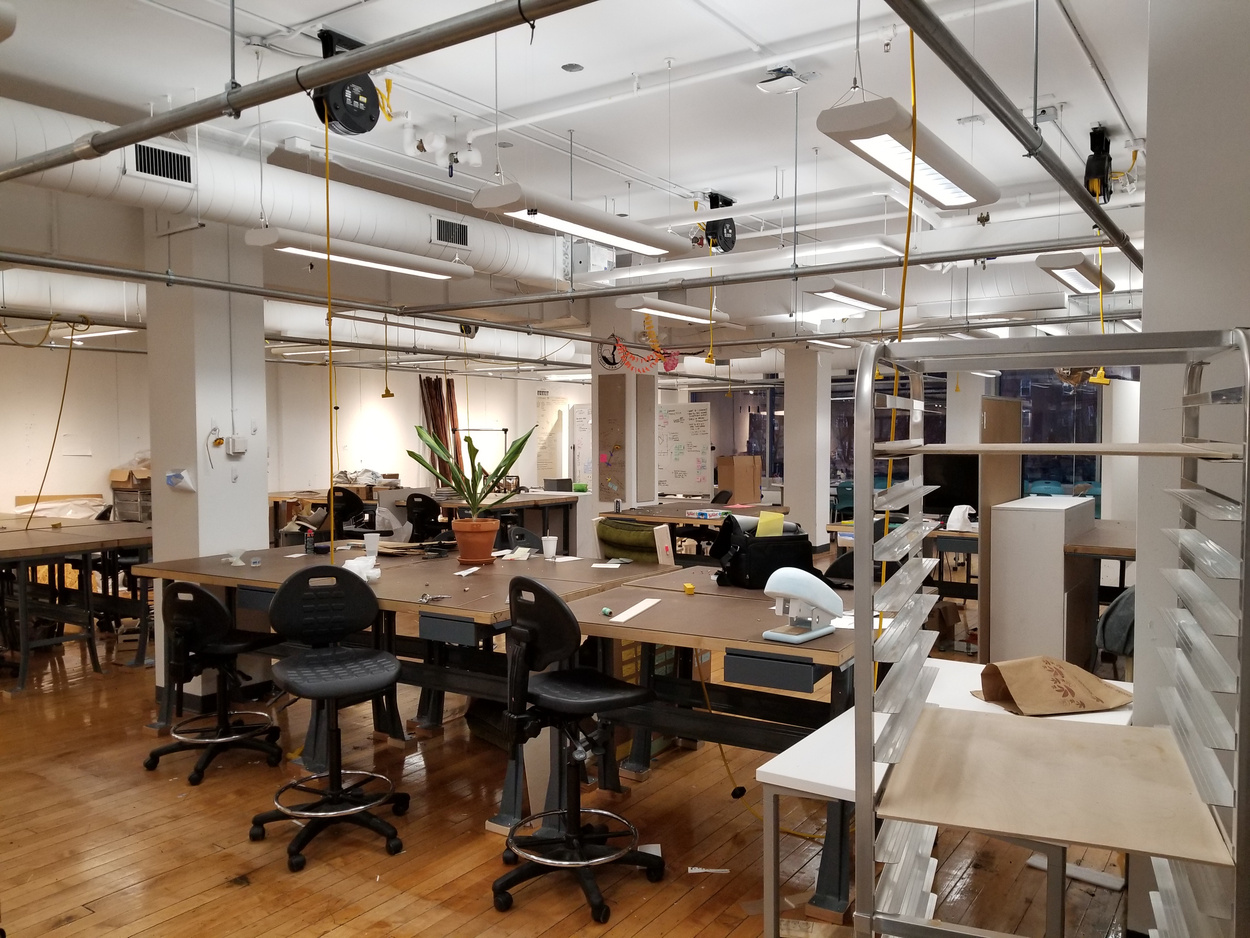3.29.20
Irina V. Wange
→MFA ID 2020
Two weeks ago, our studios—like so many other places of work and gathering across the world—were abruptly vacated by students and faculty. One week, this was an art and design school bustling with predictable amounts of pre-midterm chaos, booking logistics for the graduate exhibition; the next week, campus shut down and we cleared everything out.
 Empty CIT and current Zoom background. Photo by the author.
Empty CIT and current Zoom background. Photo by the author.Things happened impossibly fast before becoming impossibly slow, like Time making up for lost time. As the dust settles and I’m sitting indefinitely alone at home, I miss my cohort’s multi-textured piles of collective debris and semi-biological experiments lined up by the window in various stages of growth/decay. I miss the brazen agency that comes with being freshly trained and over-equipped. Because of course, the loss of studio is the loss of the lathe, the laser cutter, the jacquard, the forge, the CNC, the kiln, the letterpress, the darkroom, the tablesaw, even the damn whiteboard and spare pliers—every big and small tool for making. But the loss of studio is also the loss of a culture, which is why the work we finish will not be the work we started.
“Studio culture,” a phrase bandied about in design school, suffers from the meaning-fatigue of overuse. In my experience, it’s something professors and programs attempt to instill, but only students can sculpt with critique, commiseration, creation, exhaustion, excitement, together tempering anxiety and ambition. Crucially, every studio culture is built on the foundation of shared time, shared space, and shared context. This simple combination, sustained over semesters, does something wonderful: it matures acquaintance into a blunt familiarity that honors solidarity over compatibility. It’s the stuff of families and platoons and summer camps. It’s profound without a capital “P”—it’s rare, but also ordinary.
Like Japanese bathhouses and Parisian sidewalk cafés, the best studio cultures are an artful collision of the public sphere and the private sphere. They are spaces where the communal and the individual cross-pollinate. They can represent the liminal space between solidarity and solitary—like library nooks, hiking trails, church pews, dance floors. Late Thursday nights in the studio, each of us could be plugged into a playlist and bent over a half-formed prototype, alone together before #alonetogether.
As a semblance of Spring semester restarts tomorrow and “remote learning” launches in earnest, I try to imagine how I’d recreate a sterilized slice of the public sphere right here in my one-room quarantine cage. How will studio culture evolve or devolve when our shared time is separated from a shared space? More puzzlingly, can it continue after our shared context has been uprooted, dissolved, displaced by pandemic?
My cohort and I were set to graduate with our master’s degrees and masterpiece theses this May, a once-singular focus that now seems both trivially simple and impossible to attempt. We had always been proud to mark out our niche and work hard to amplify its value in the world. Right now, that pride is difficult to admit and act on. Yes, there is still too much carbon dioxide in the atmosphere; yes, socioeconomic inequality still plagues climate solutions; yes, the privacy of our healthcare data is still compromised; yes, polarization is still stunting our quality of conversation; yes, gender stereotypes are still driving product development and division of labor; yes, hyper-connective technology is still altering our behaviors and spaces. Acknowledging that our Pet Problems retain—even gain—urgency in this quarantine, many of us may still feel unmotivated to vie for importance during a pandemic. In order to get any thesis work done, I have had to remind myself that equitable carbon sequestration will still matter when COVID-19 no longer does; it is an awful mantra to repeat while 3.3 million Americans file for unemployment and 33,000 have already died around the world. It seems my dissociation would have to grow along with those numbers.
But in reality and throughout history, tragedies have always risen simultaneously and in multitudes. We will experience the cognitive dissonance of ranking urgencies as long as we model our internal landscape after competing media headlines and zero-sum congressional budgets. Instead, I have to remind myself that equitable carbon sequestration still matters a whole lot even as COVID-19 also suddenly matters a whole lot. It also matters to the struggling local restaurant I bike to through the rain to pick up dinner sometimes. It also matters to healthcare workers and the immunocompromised that I otherwise stay inside. It definitely matters to my sanity that I invent reasons to continue waking up early and putting on pants.
It’ll be the challenge of newfangled remote studio culture to help me hold all these things up at the same time, and more. For the first time in weeks, I feel a rush of something like encouragement or relief. Maybe some normalcy and motivation will return through the sheer force of banal familiarity, inherited from the two years of shared times and spaces that keep on giving. Foolishly, I look forward to seeing everyone’s face pop up in a patchwork of video squares. This never could have been a job for the individual without the communal, and there’s still time to shape these new commons.